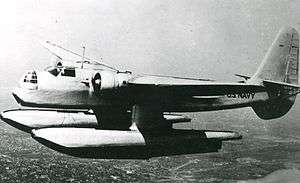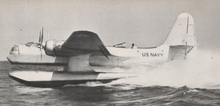Hall XPTBH
| XPTBH | ||
|---|---|---|
 | ||
| The XPTBH-2 in flight | ||
| Role | Seaplane torpedo-bomber | |
| Manufacturer | Hall Aluminum Aircraft Corporation | |
| First flight | February 1937 | |
| Retired | September 21, 1938 | |
| Primary user | United States Navy | |
| Number built | 1 | |
| Program cost | $309,000 USD[1] | |
|
|
Type | Prototype |
| Serial | 9721[2] | |
| Fate | Destroyed in hurricane September 21, 1938 | |
The Hall XPTBH was a prototype American twin-engined seaplane, submitted to the United States Navy by the Hall Aluminum Aircraft Corporation in response to a 1934 specification for new bomber and scout aircraft. Constructed in an innovative fashion that made extensive use of aluminum, the XPTBH proved successful in flight testing, but failed to win favor with the U.S. Navy. No production contract was awarded, and the single aircraft built served in experimental duties before its destruction in a hurricane during 1938.
Design and development
In late 1934, the U.S. Navy's Bureau of Aeronautics (BuAer) issued a specification for new scout bomber and torpedo bomber designs.[3] Eight companies submitted a total of ten designs in response, evenly split between monoplanes and biplanes.[4][N 1] The Hall Aluminum Aircraft Company submitted the only seaplane design;[4] a single prototype was ordered by the Navy for evaluation on June 30, 1934. Given the designation XPTBH-1,[6] it became the only aircraft to receive three mission-type letters under the U.S. Navy's designation system used between 1922 and 1962.[7][8][9]
Hall's choice of the twin-float seaplane configuration was dictated by the Navy's requirement that the new torpedo-bomber design should be capable of carrying a standard naval torpedo of the type carried by destroyers.[10] As ordered, the XPTBH-1 was intended to be fitted with Wright R-1820 "Cyclone" radial engines;[6] delays in design caused by Hall relocating their production facility, difficulties with the contract, and doubts about the aircraft's performance potential led to a redesign, the aircraft becoming slightly smaller and the engines being changed to a pair of Pratt & Whitney R-1830 "Twin Wasp" radials.[1] The changes to the aircraft resulted in it receiving the revised designation XPTBH-2.[10]
Utilising Hall's standard aluminum tubular spar,[10] the fuselage and wing leading edges were covered in aluminum, while the rest of the wing and the control surfaces were fabric-covered.[10] The aircraft was well-armed defensively by 1930s standards, with a powered turret, designed by Hall, mounted in the nose and carrying a single .30-caliber machine gun.[10] Hand-traversed mountings for a pair of machine guns were fitted in dorsal (top) and ventral (belly) positions aft.[10] An optically flat glass panel was fitted in the nose below the turret for use by the bombardier;[10] the aircraft's offensive weaponry, consisting of a Mark XIII aerial torpedo or, alternatively, up to 2,000 pounds (910 kg) of bombs,[10] was carried in an internal bomb bay, the twin-float arrangement allowing for a clear release of the weaponry.[6]
Operational history
Delivered to the Navy on January 30, 1937,[6][11][N 2] the aircraft was officially presented to the public at Hall's Bristol, Pennsylvania factory in April of that year.[10] The aircraft's early flight testing, starting in February[1] and conducted by test pilot Bill McAvoy,[6][10] showed that the XPTBH had few faults, with the only significant issue being a lack of roll authority – a reduction of the ability of the ailerons to turn the aircraft – as a result of the surface area of the floats.[10] A modification to increase the area of the rudder solved the issue.[10] The aircraft's water-handling characteristics were found to be excellent;[13] the only significant complaints that surfaced during the testing period concerned the XPTBH-2's beaching gear, which was found to be extremely difficult to use in anything other than the calmest water.[13]
Although the XPTBH-2 met most of its design specifications and was rated overall very good in flight testing,[6][13] it failed to meet the contractual requirements for top speed and attack speed.[1] In addition, the U.S. Navy did not consider a seagoing torpedo-bomber to be an aircraft for which there was an operational requirement;[10] the fact that as a floatplane the aircraft was restricted to operation from water was also considered a negative,[5] while the aircraft's "three-in-one" role led it to be viewed as a jack of all trades, purpose-designed aircraft for each role being considered superior.[14] The company, however, blamed Navy politics for the lack of a production order.[13]
Following the conclusion of its test program, the XPTBH-2 was used for experimental duties at the Naval Torpedo Station in Newport, Rhode Island, participating in trials of aerial torpedoes.[1] Its service at Newport came to an end on September 21, 1938, when the XPTBH-2 was destroyed during the Great New England Hurricane.[13] The XPTBH-2 was the last aircraft designed by Hall Aluminum;[10] the company remained in business until 1940, when it was bought out by Consolidated Aircraft.[15][N 3]
Specifications (XPTBH-2)

Data from Wegg 1990,[6] Trimble 2005,[1] Boyne 2001[13]
General characteristics
- Crew: four (pilot, copilot/navigator/bombardier, flight mechanic/gunner, radio operator/gunner)
- Length: 55 ft 11 in (17.04 m)
- Wingspan: 79 ft 4 in (24.18 m)
- Height: 24 ft 1 in (7.34 m)
- Wing area: 828 sq ft (76.9 m2)
- Airfoil: Clark YM[17]
- Empty weight: 11,992 lb (5,439 kg)
- Gross weight: 17,983 lb (8,157 kg)
- Max takeoff weight: 21,414 lb (9,713 kg)
- Powerplant: 2 × Pratt & Whitney XR-1830-60 radial piston engines, 800 hp (600 kW) each
- Propellers: 3-bladed Curtiss constant-speed
Performance
- Maximum speed: 182 mph; 293 km/h (158 kn)
- Cruise speed: 170 mph (148 kn; 274 km/h)
- Range: 2,621 mi; 4,219 km (2,278 nmi)
- Combat range: 850 mi; 1,369 km (739 nmi) with torpedo
- Service ceiling: 20,400 ft (6,218 m) at 17,983 pounds (8,157 kg) mission weight
- Time to altitude: 5.3 minutes to 5,000 feet (1,500 m)
- Wing loading: 25.8 lb/sq ft (126 kg/m2)
Armament
- Guns: 2 x .30-caliber machine guns in nose turret and dorsal position; 1 x .30-cal or .50-cal machine gun in ventral position
- Bombs: One Mark XIII torpedo or up to 2,000 pounds (910 kg) bombs
See also
- Aircraft of comparable role, configuration and era
- Related lists
References
Notes
- ↑ The designs submitted, in total, were the Brewster SBA, Curtiss SBC, Douglas TBD, Great Lakes XB2G, Great Lakes XTBG, Grumman XSBF, Hall XPTBH, Northrop BT (which became the SBD Dauntless), Vought SB2U and Vought XSB3U;[4] the XTBD and XTBG were the XPTBH's main competitors.[5]
- ↑ A Navy source gives December 17, 1936 as the acceptance date.[12]
- ↑ Deliveries of the Hall PH, a biplane flying boat which first flew in 1929, continued until 1941.[16]
Citations
- 1 2 3 4 5 6 Trimble 2005, p.14.
- ↑ Baugher 2011
- ↑ Dann 1996, p.20.
- 1 2 3 Doll 1992, p.4.
- 1 2 Windrow 1970, pp.28–29.
- 1 2 3 4 5 6 7 Wegg 1990, p.115.
- ↑ Swanborough and Bowers 1990, p.8.
- ↑ Kelly and Riley 1997, p.35.
- ↑ Boyne 2001, p.59.
- 1 2 3 4 5 6 7 8 9 10 11 12 13 14 Boyne 2001, p.60.
- ↑ Wagner 1960, p.335.
- ↑ Van Fleet et al. 1985, p.90.
- 1 2 3 4 5 6 Boyne 2001, p.61.
- ↑ Trimble 1982, p.207.
- ↑ Pattillo 2000, p.105.
- ↑ Wegg 1990, p.113.
- ↑ Lednicer 2010
Bibliography
- Baugher, Joe (October 5, 2009). "US Navy and US Marine Corps BuNos, First Series (A6002 to 9999)". US Navy and US Marine Corps Aircraft Serial Numbers and Bureau Numbers—1911 to Present. Retrieved 2011-01-22.
- Boyne, Walter J. (2001). The Best of Wings: Great Articles from Wings and Airpower Magazines. Dulles, VA: Brassey's. ISBN 1-57488-368-2.
- Dann, Richard S. (1996). Grumman Biplane Fighters in action. Aircraft In Action. 150. Carrollton, TX: Squadron/Signal Publications. ISBN 0-89747-353-1.
- Doll, Tom (1992). SB2U Vindicator in action. Aircraft In Action. 122. Carrollton, TX: Squadron/Signal Publications. ISBN 0-89747-274-8.
- Kelly, Harold H.; William A. Riley (1997). Enlisted Naval Aviation Pilots: USN-USMC-USCG, 1916–1981. Paducah, KY: Turner Publishing. ISBN 978-1-56311-110-5. Retrieved 2011-01-22.
- Lednicer, David (2010). "The Incomplete Guide to Airfoil Usage". University of Illinois at Urbana-Champaign. Retrieved 2010-11-27.
- Pattillo, Donald M. (2000). Pushing the Envelope: The American Aircraft Industry. Ann Arbor, MI: University of Michigan Press. ISBN 978-0-472-08671-9. Retrieved 2011-01-22.
- Swanborough, Gordon; Peter M. Bowers (1990). United States Navy Aircraft since 1911 (3rd ed.). London: Putnam. ISBN 978-0-87021-792-0.
- Trimble, William F. (1982). High Frontier: A History of Aeronautics in Pennsylvania. Pittsburgh, PA: University of Pittsburgh Press. ISBN 0-8229-5340-4. Retrieved 2011-01-22.
- Trimble, William F. (2005). Attack from the Sea: A History of the U.S. Navy's Seaplane Striking Force. Annapolis, MD: Naval Institute Press. ISBN 1-59114-878-2. Retrieved 2011-01-22.
- Van Fleet, Clarke; Armstrong, William J.; E.R. Seymour; W.L. McDonald (1985). United States Naval Aviation 1910–1980. NAV AIR 00-80P-1. Washington, D.C.: Government Printing Office. ASIN B000QB7T3O. Retrieved 2011-01-22.
- Wagner, Ray (1960). American Combat Planes (1st ed.). Garden City, NY: Hanover House. ASIN B0007DNHZK.
- Wegg, John (1990). General Dynamics Aircraft and their Predecessors. London: Putnam. ISBN 0-85177-833-X.
- Windrow, Martin (1970). Aircraft in Profile. 8. New York: Doubleday. ASIN B001IS060M. Retrieved 2011-01-22.
External links
| Wikimedia Commons has media related to Hall XPTBH. |
- "Hall XPTBH-2", Aviation Enthusiast Corner
- American airplanes: Ha – Hu, Aerofiles
- June 1938 cover, Model Airplane News